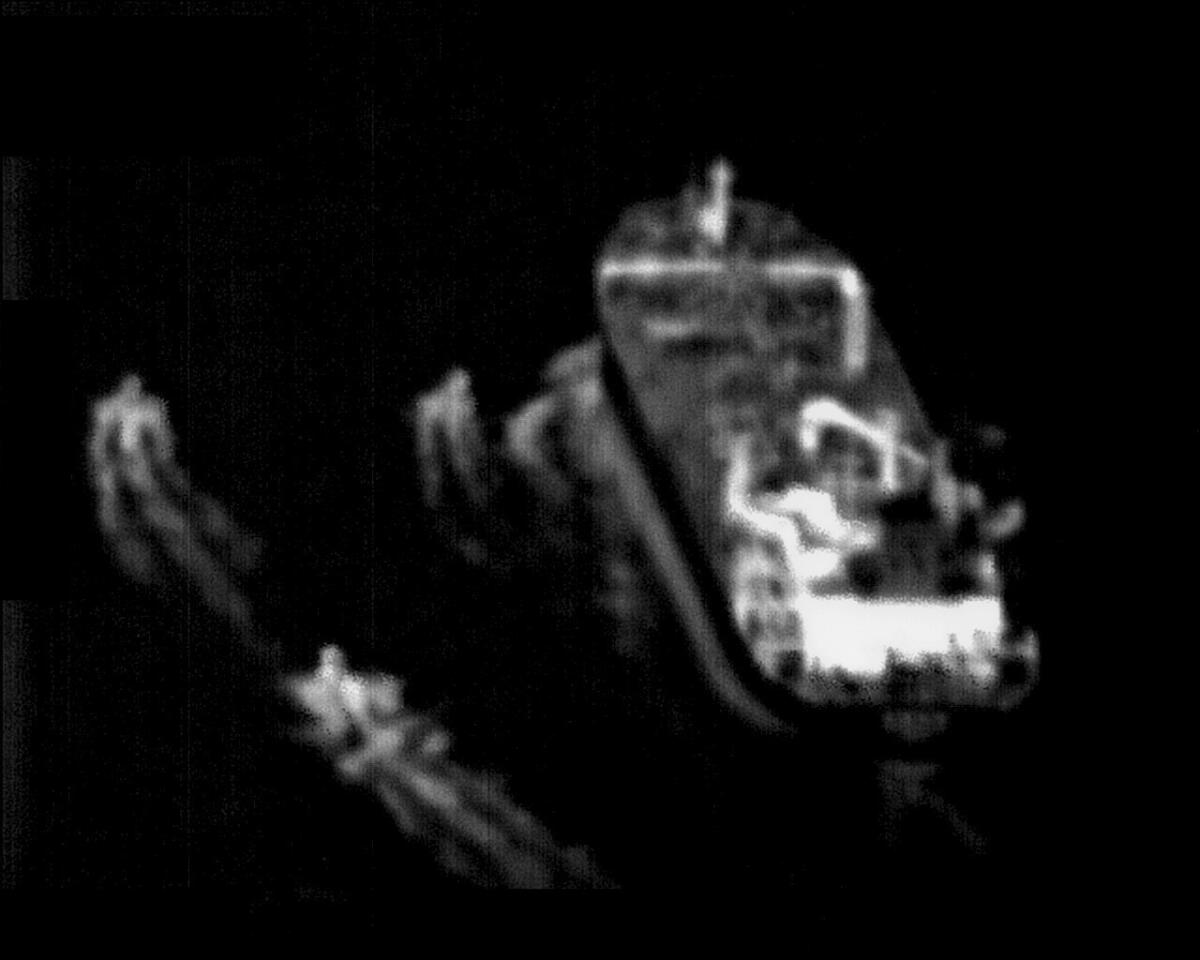U.S., British navies say they responded to distress call as Iran’s Revolutionary Guard ‘harassed’ ship

- Share via
DUBAI, United Arab Emirates — The U.S. Navy said its sailors and the United Kingdom Royal Navy came to the aid of a ship in the crucial Strait of Hormuz after Iran’s Islamic Revolutionary Guard “harassed” it.
Three fast-attack Revolutionary Guard vessels with armed troops aboard approached the merchant ship at a close distance Sunday afternoon, the U.S. Navy said in a statement. It offered black-and-white images it said came from a U.S. Navy Boeing P-8 Poseidon overhead video, which showed three small vessels close to the commercial ship.
The U.S. Navy’s guided-missile destroyer USS McFaul and the Royal Navy’s frigate HMS Lancaster responded to the incident, with the Lancaster launching a helicopter.
“The situation deescalated approximately an hour later when the merchant vessel confirmed the fast-attack craft departed the scene,” the Navy said. “The merchant ship continued transiting the Strait of Hormuz without further incident.”
The Strait of Hormuz, the narrow mouth of the Persian Gulf, sees 20% of the world’s oil pass through it.
Gov. Gavin Newsom is under pressure from allies to begin spending money on healthcare that the state raised by fining Californians who forgo health insurance.
While the Navy did not identify the vessel involved, ship-tracking data from MarineTraffic.com analyzed by the Associated Press showed the Marshall Islands-flagged bulk carrier Venture erratically changed course as it traveled through the strait at the time of the incident. Its location also matched information about the incident given by the United Kingdom Maritime Trade Operations, a British military operation overseeing traffic in the region. The vessel resembled the one in the images released by the Navy.
The ship’s registered manager, Trust Bulkers of Athens, did not immediately respond to a request for comment.
Iranian state media and the Revolutionary Guard did not immediately acknowledge the incident. Iran’s mission to the United Nations did not immediately respond to a request for comment.
The episode comes after a series of other maritime incidents involving Iran after the U.S. unilaterally withdrew from the nuclear deal between Tehran and world powers in 2018.
The suspected American seizure of the Suez Rajan, a tanker linked to a U.S. private equity firm believed to have been carrying sanctioned Iranian crude oil off Singapore, probably prompted Tehran to recently take the Marshall Islands-flagged tanker Advantage Sweet. That ship carried Kuwaiti crude oil for energy firm Chevron Corp. of San Ramon in the Bay Area.
While authorities have not acknowledged the Suez Rajan’s seizure, the vessel is now off the coast of Galveston, Texas, according to ship-tracking data analyzed by the AP.
Meanwhile, Iran separately seized the Niovi, a Panama-flagged tanker, as it left a dry dock in Dubai bound for Fujairah on the United Arab Emirates’ eastern coast. While not carrying any cargo, data from S&P Global Market Intelligence seen by the AP showed the Niovi in July 2020 received oil from a ship known then as the Oman Pride.
The U.S. Treasury Department in August 2021 sanctioned the Oman Pride and others associated with the vessel over it being “involved in an international oil smuggling network” that supported the Quds Force, the expeditionary unit of the Revolutionary Guard that operates across the Mideast. Purported emails published online by Wikiran, a website that solicits leaked documents from Iran, suggest that cargo carried by the Niovi was sold to firms in China without permission.
Satellite images analyzed by the AP show those two vessels anchored off Bandar Abbas, Iran.
The recent seizures have put new pressure on the U.S., long the security guarantor for gulf Arab nations. The United Arab Emirates said last week that it earlier “withdrew its participation” from a joint naval command called Combined Maritime Forces, though the U.S. Navy said it was still in the group. Meanwhile, the U.S. military’s Central Command said Saturday its chief visited the region, met with Emirati leader Sheikh Mohammed bin Zayed al Nahyan and “discussed shared regional security concerns as well as U.S. and UAE security partnerships.”
The Mideast-based commanders of the U.S., British and French navies also transited the Strait of Hormuz on Friday aboard an American warship, a sign of their unified approach to keep the crucial waterway open after Iran seized the two oil tankers.
More to Read
Sign up for Essential California
The most important California stories and recommendations in your inbox every morning.
You may occasionally receive promotional content from the Los Angeles Times.














